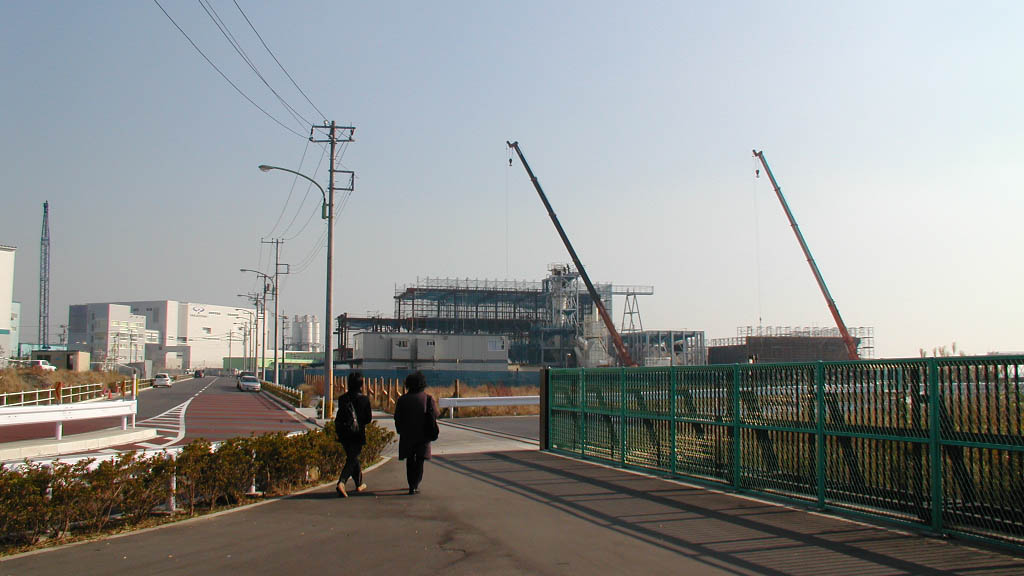「完成直後のリサイクル工場で何かできないか」と声をかけられたことから全ては始まった。
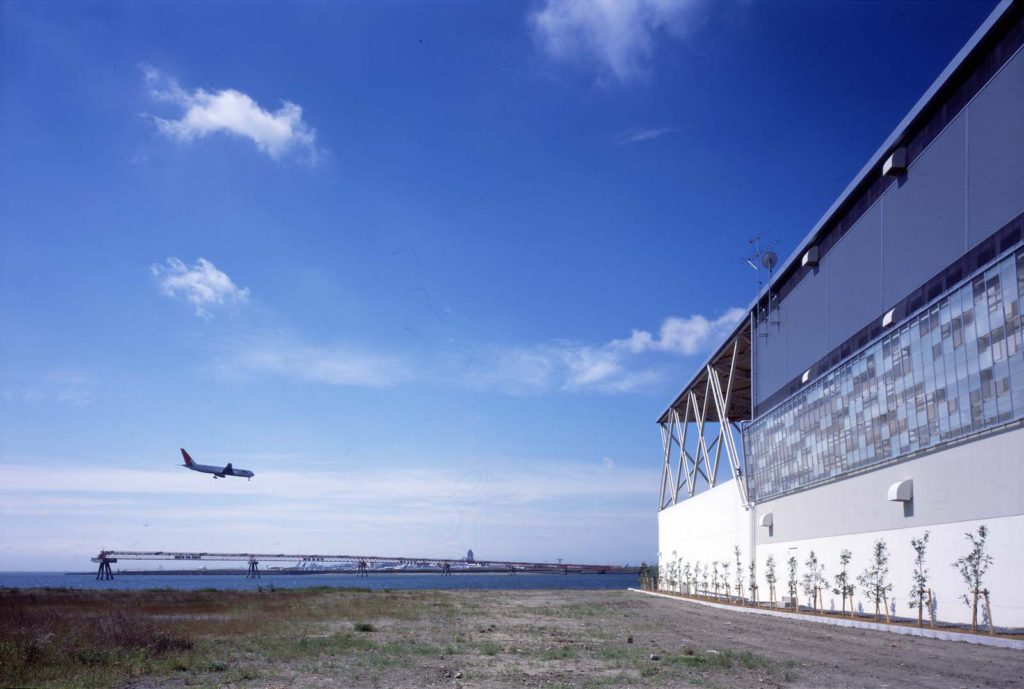
飛行機とリーテム東京工場
写真提供:O.F.D.A.
設計プランを聞き、実際の建設予定地に足を運んで出した結論は、その工場でエキシビションを行うというものだった。東京湾の人工島に立地する特徴的な工場空間、そして対岸には羽田空港が位置し、飛行機が頭上をかすめて行き来するというランドスケープ/サウンドスケープのただなかで、その強烈な物理的・社会的環境とアーティストたちの創り出す作品とが干渉し、多様に響き合う〈場〉になることを目指した。私たちSETENVからアーティストに伝えたのは、そのような環境を前提とし、この場所を意識した作品にしてほしいということのみだった。主に使用済みの電子機器から金属を回収するリサイクル工場である。アーティストは、実際に稼働している既存のリサイクル工場を見学し、建設現場にも足を運び、継続的にやりとりを重ねながら作品を準備した。リサイクル工場とアーティストの邂逅、ストレートではあるが、それが本プロジェクトの核である。
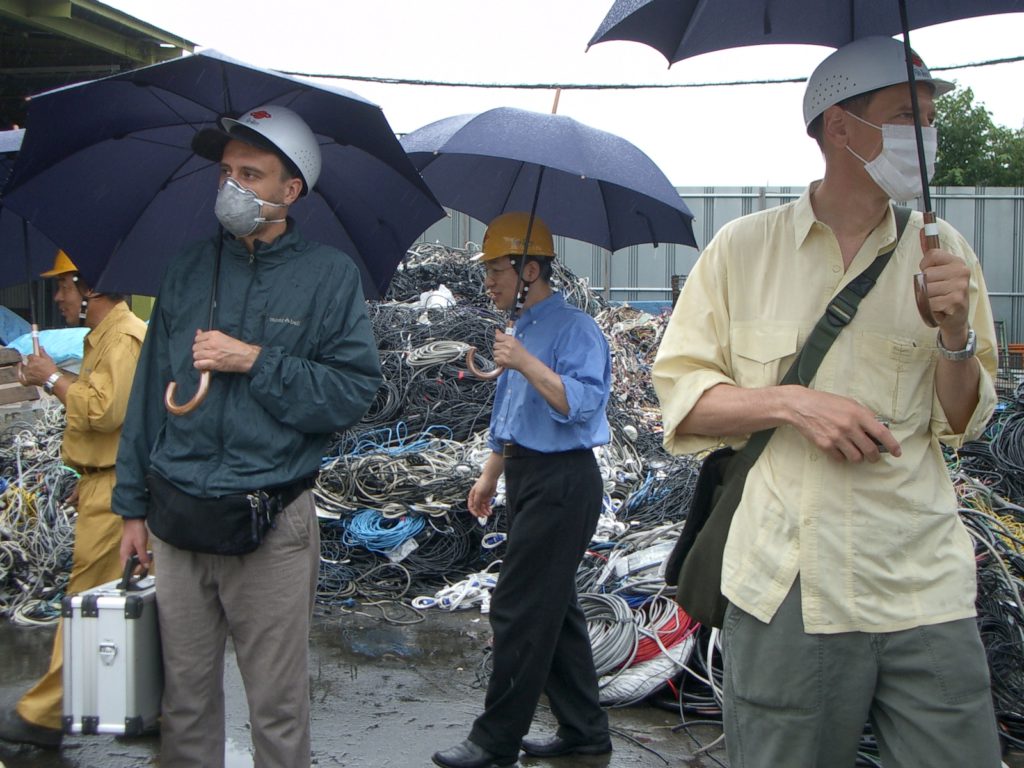
リーテム水戸工場見学の様子
撮影:光岡寿郎
Photography: Toshiro Mitsuoka
完成直後のリーテム東京工場
撮影:渡邊修
Photography: Osamu Watanabe
刀根康尚は〈グループ・音楽〉などを通じて日本の前衛芸術に大きな影響を残し、72年に渡米したアーティスト。90年代に入って作品がCDでリリースされるようになると、サウンド・アートやテクノ以降の電子音楽の文脈からも驚嘆をもって迎えられた。今回は、周囲の環境音、工場の作業音などを取り込み、センサーによって検知される観客の動きに合わせて変化するサウンド・インスタレーションを制作。一瞬として同じ音はなく、観客は知らず知らずのうちに自らも「騒音」のリサイクルの過程に組み込まれていく。
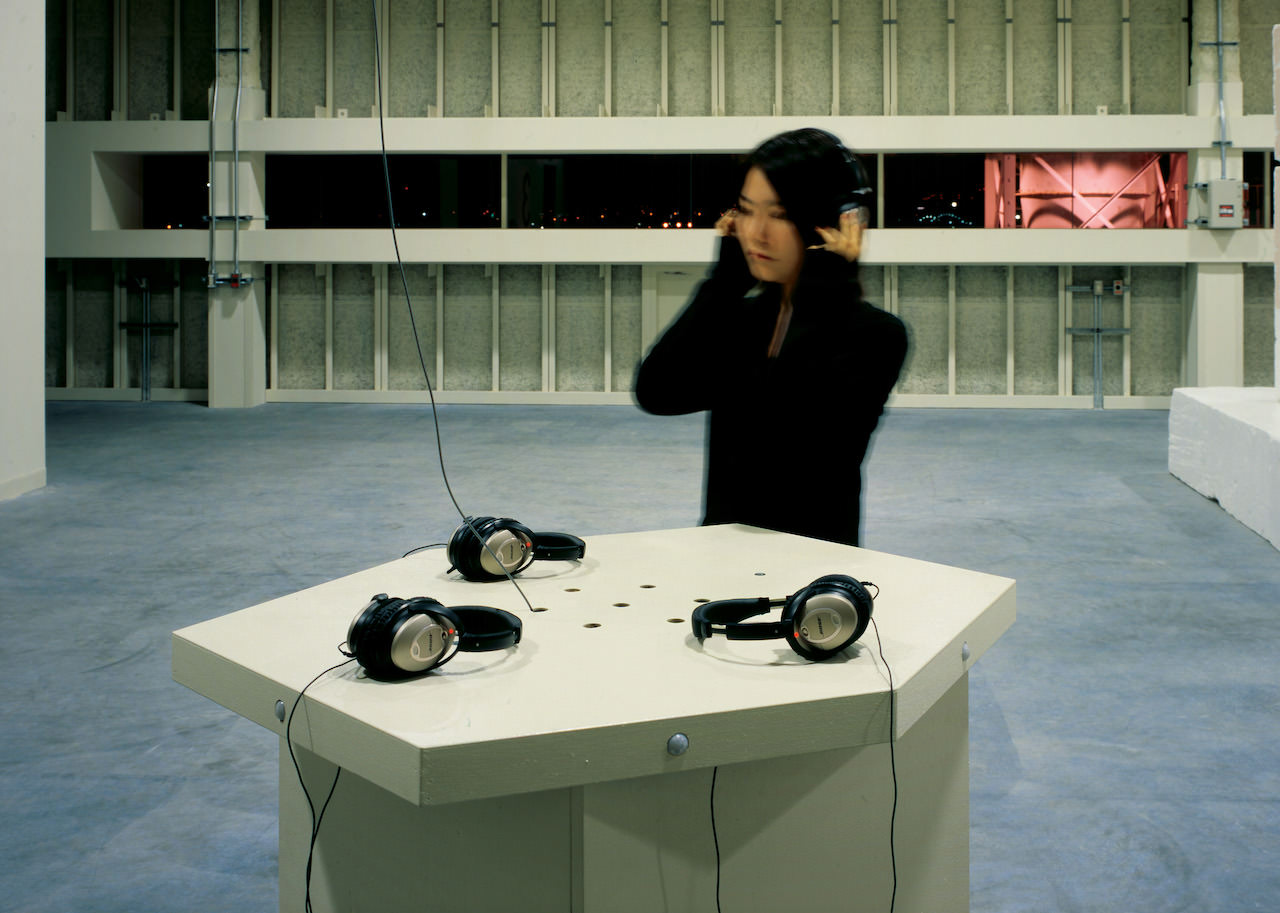
刀根康尚《遠心的パラメディア》2005
モーションセンサーシステム、音響機器、箱
(ソフトウェア・デザイン:マーク・フェル)
撮影:渡邊修
Yasunao Tone
“Paramedia Centrifugal”, 2005
motion sensor system, sound equipments, box
(Software design: Mark Fell)
Photography: Osamu Watanabe
クリスチャン・マークレーはターンテーブル演奏の先駆者であり、また、レコード、楽器、楽譜など、音に関連する事物を素材とするインスタレーションで国際的な注目を集めるアーティストでもある。今回の作品では、任務を終えたデスクトップPC、ラップトップPC、そして携帯電話のスクリーンに、それら自身がバラバラに解体され分別されていく工程が映し出される。それらの製品が本来発していたはずの音とはかけ離れた、リサイクル過程で響かせる音も、重要な要素だ。機械たちが自らの無意識や夢を語っているかのような傑作が生まれた。
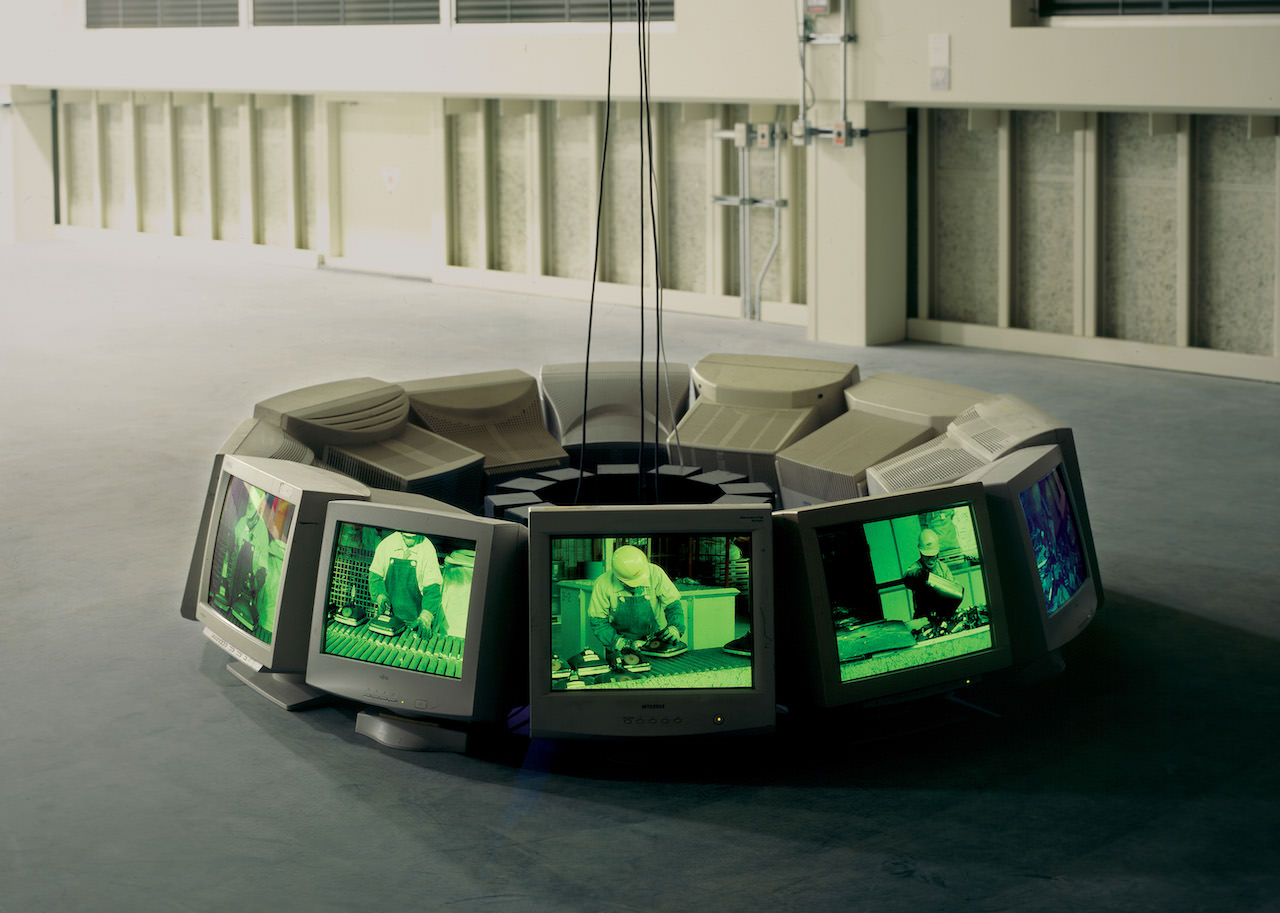
クリスチャン・マークレー
《リサイクリング・サークル》 2005
PCモニター12台、DVDプレイヤー、スピーカー
撮影:渡邊修
Christian Marclay
“Recycling Circle”, 2005
12 PC monitors, DVD players, speakers
Photography: Osamu Watanabe
*2005年当時の作品情報

クリスチャン・マークレー
《ラップトップ・プレイヤーズ(デュエット)》 2005
ラップトップコンピュータ2台、映像ファイル
撮影:渡邊修
Christian Marclay
“Laptop Players (Duet)”, 2005
2 Laptops, video files
Photography: Osamu Watanabe
*2005年当時の作品情報
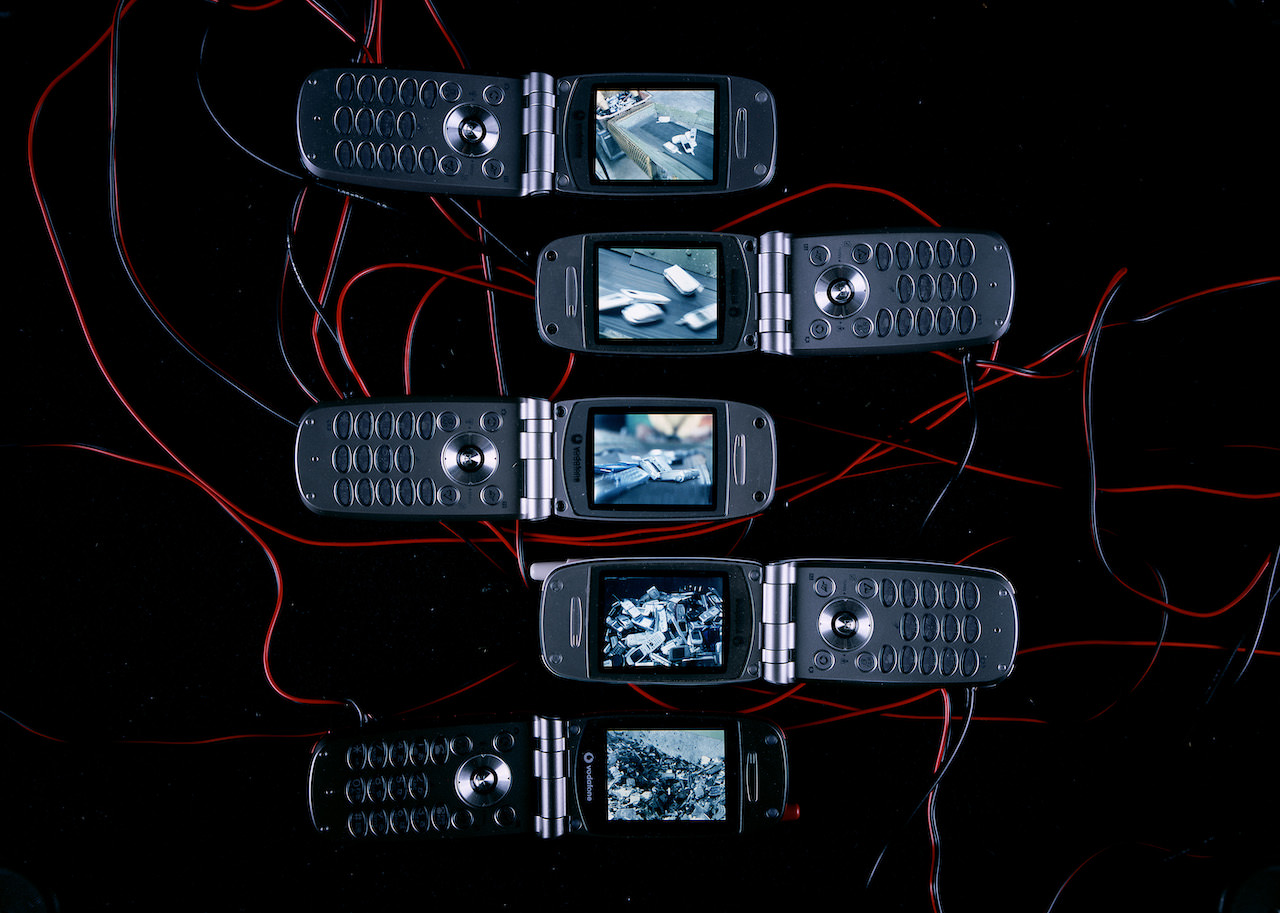
クリスチャン・マークレー
《携帯電話》 2005
携帯電話5台、DVDプレイヤー5台、スピーカー、アンプ
撮影:渡邊修
Christian Marclay
“Cell Phones”, 2005
5 cell phones, 5 DVD players, speakers, amplifier.
Photography: Osamu Watanabe
*2005年当時の作品情報
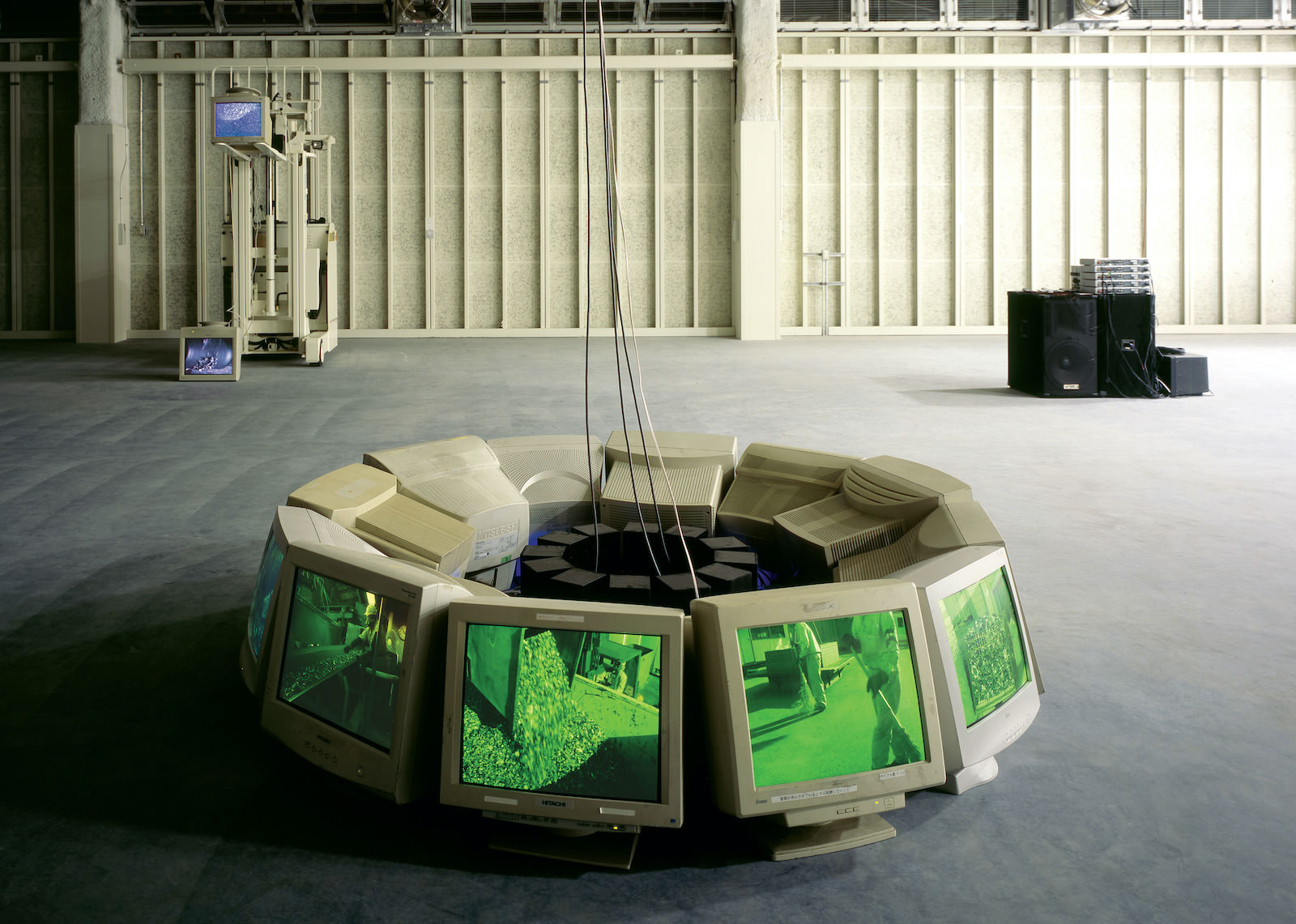
左:
クリスチャン・マークレー
《昇天》 2005
PCモニター2台、DVDプレイヤー2台、フォークリフト
*中央は《リサイクリング・サークル》、右は《携帯電話》
撮影:渡邊修
Left:
Christian Marclay
“Ascension”, 2005
2 PC monitors, 2 DVD players, fork lift
*Center: “Recycling Circle” / Right: “Cell Phones”
Photography: Osamu Watanabe
*2005年当時の作品情報
近藤一弥は、安部公房の最後の仕事部屋と彼のフロッピーに残された未完の小説を主題とする映像インスタレーションを出展。2002年以来進化しつづけているこの作品に会場の特徴を取り込んでシェルター的な空間を構築し、映像もヴァージョンアップした。現実とそれを映し出すイメージが、常に合わせ鏡のように無限に連鎖し、響きあう。
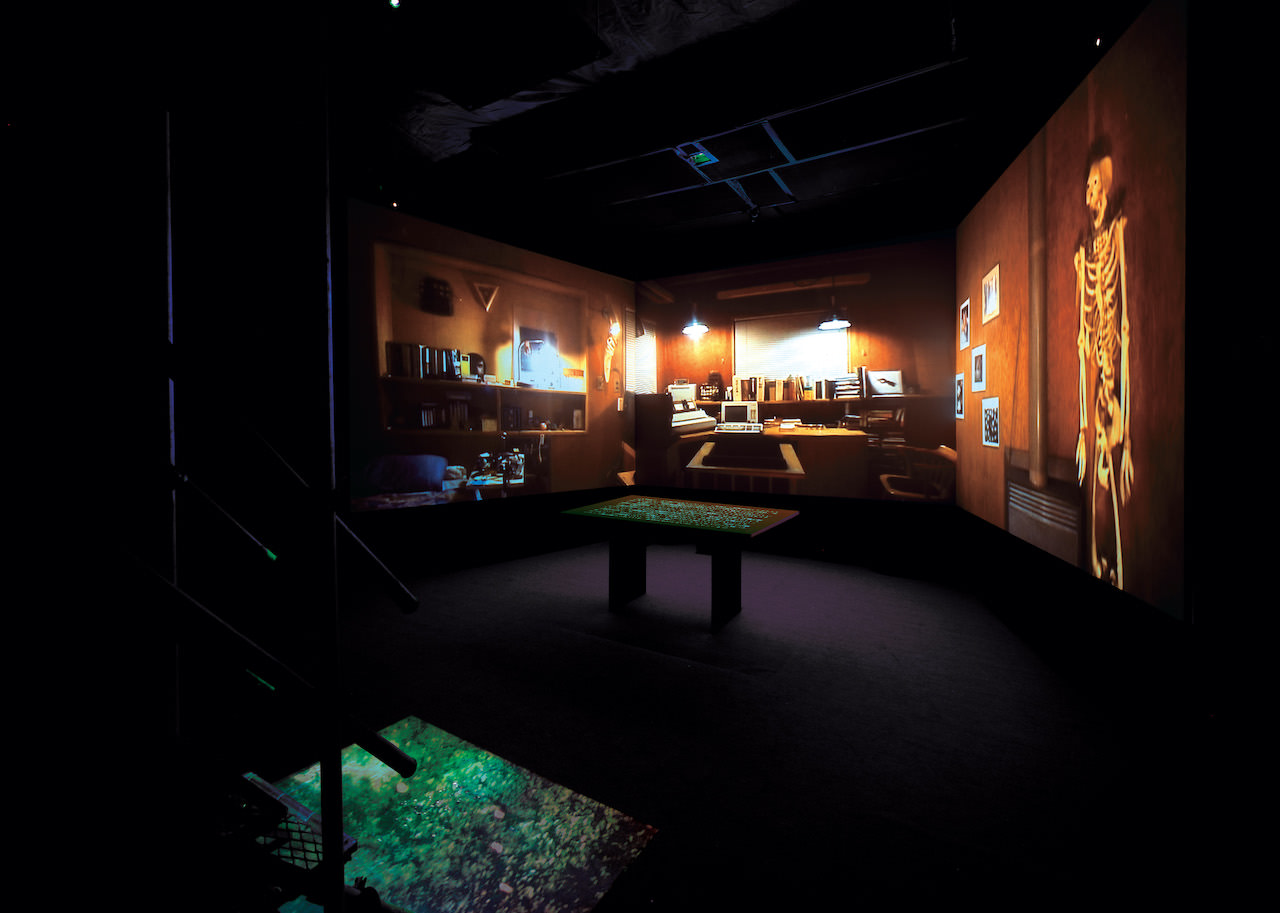
近藤一弥
《飛ぶ男》 2002−2005
プロジェクター、サーモセンサー、スピーカー、DVD(約14分)
(テキスト、写真:安部公房)
撮影:渡邊修
Kazuya Kondo
“Flying Man”, 2002-05
projectors, thermo sensors, speakers, DVD (approx.14min.)
(Text, Photo: Kobo Abe)
Photography: Osamu Watanabe
ポル・マロは、工場建設の際に廃材となった大量の発泡スチロールを利用したインスタレーションを、現地で1ヶ月かけて制作した。やわらかな色合いの発泡スチロールが林立し、ほのかにアロマが漂う、懐かしさを感じさせると同時に新鮮な空間を構成している。「脳のリサイクル」としての想起の問題がテーマである。

ポル・マロ
《ミラーズ》 2005
発泡スチロール、アクリルペンキ、生地、アロマポット
撮影:渡邊修
Pol Malo
“Mirrors”, 2005
polystyrene plastic, acryl paint, textile, aroma burners.
Photography: Osamu Watanabe
平倉圭は、工場での解体過程を見つめ、そこに彼が「準−部分」と名づけることになった、ある不確定な状態のモノを見出す。解体の中間過程にあるモノは、意味のある「フォルム」でもなく、意味を消去された「マテリアル」でもない、あいまいな何かだ。この「準−部分」の生成過程の映像と、その記述を試みるテキストが、3つのスクリーンに映し出される。

平倉圭
《テキスト、山、準-部分》 2005
DVDプレイヤー、スクリーン、プロジェクター、台
撮影:渡邊修
Kei Hirakura
“Text, Mountain, Quasi-parts”, 2005
DVD players, screens, projectors, pedestals
Photography: Osamu Watanabe
vokoiと古舘健によるユニット710.beppoは、鉄板に取り付けられた工業用バイブレーターをコンピュータで制御し、物体の振動そのものを時間軸上で操作することで「音楽」として提示する作品を制作。観客はその「楽器」の上に乗り、それを直に体感する。この作品も、その発想の源泉のひとつに、リサイクル工場で用いられる金属破砕機の振動が存在している。
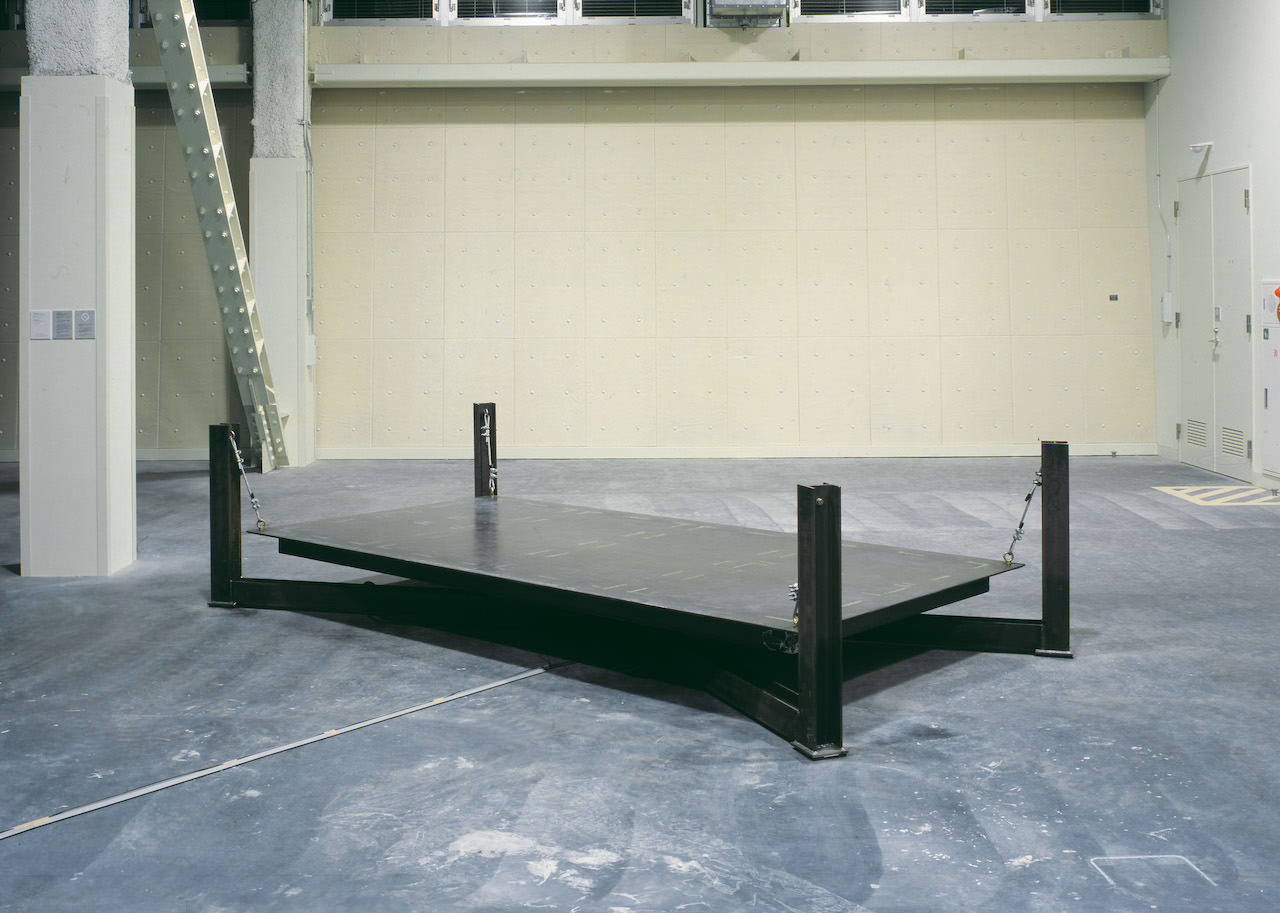
710.beppo
《0.7 tons for music》 2005
鋼鉄、工業用バイブレータ
撮影:渡邊修
710.beppo
“0.7 tons for music”, 2005
steel, vibrators
Photography: Osamu Watanabe
こうした展示と並行して、関連イベントも行われた。マークレーとフロー・カウフマンによる、ターンテーブルとレコードカッターを駆使したコンセプチュアルなパフォーマンス「タブラ・ラサ」では、自己生成する音のリサイクルが工場で展開された。
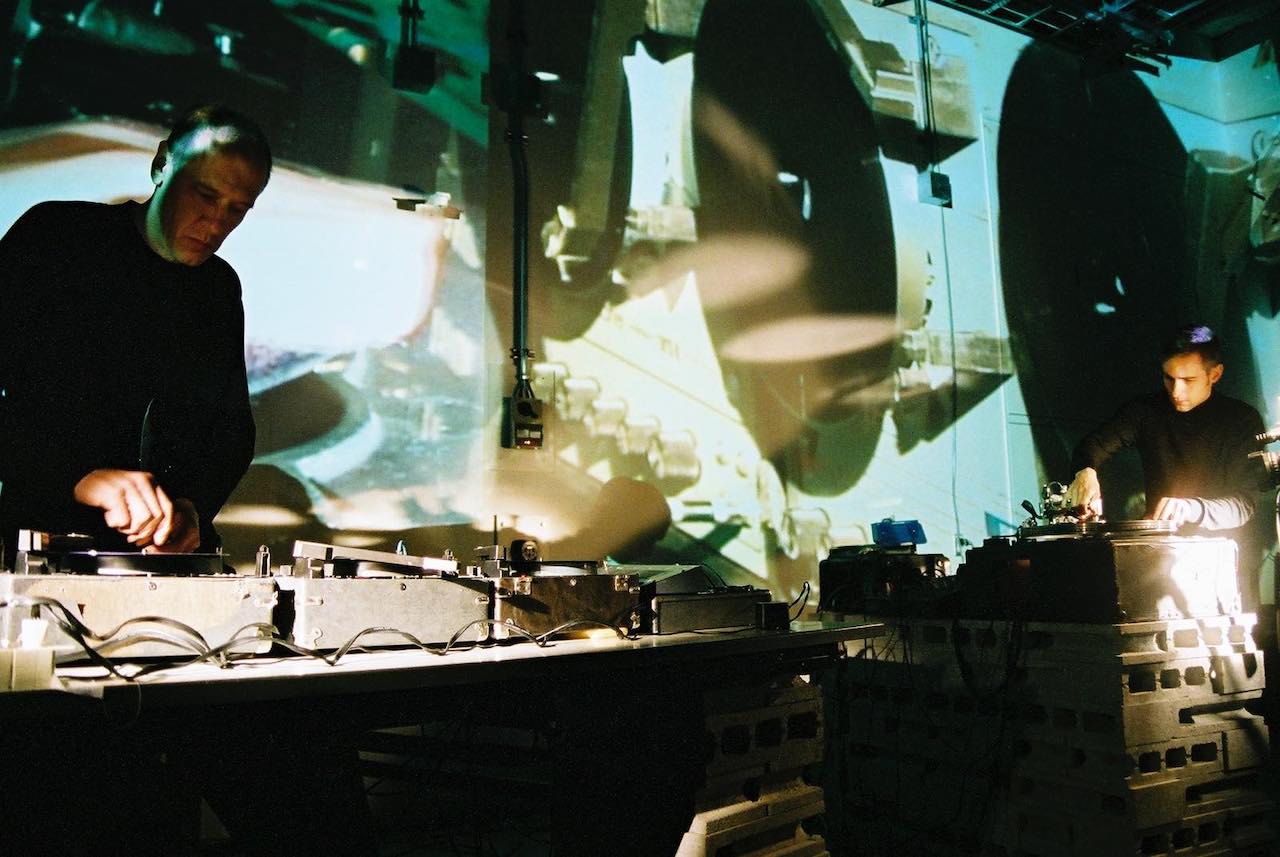
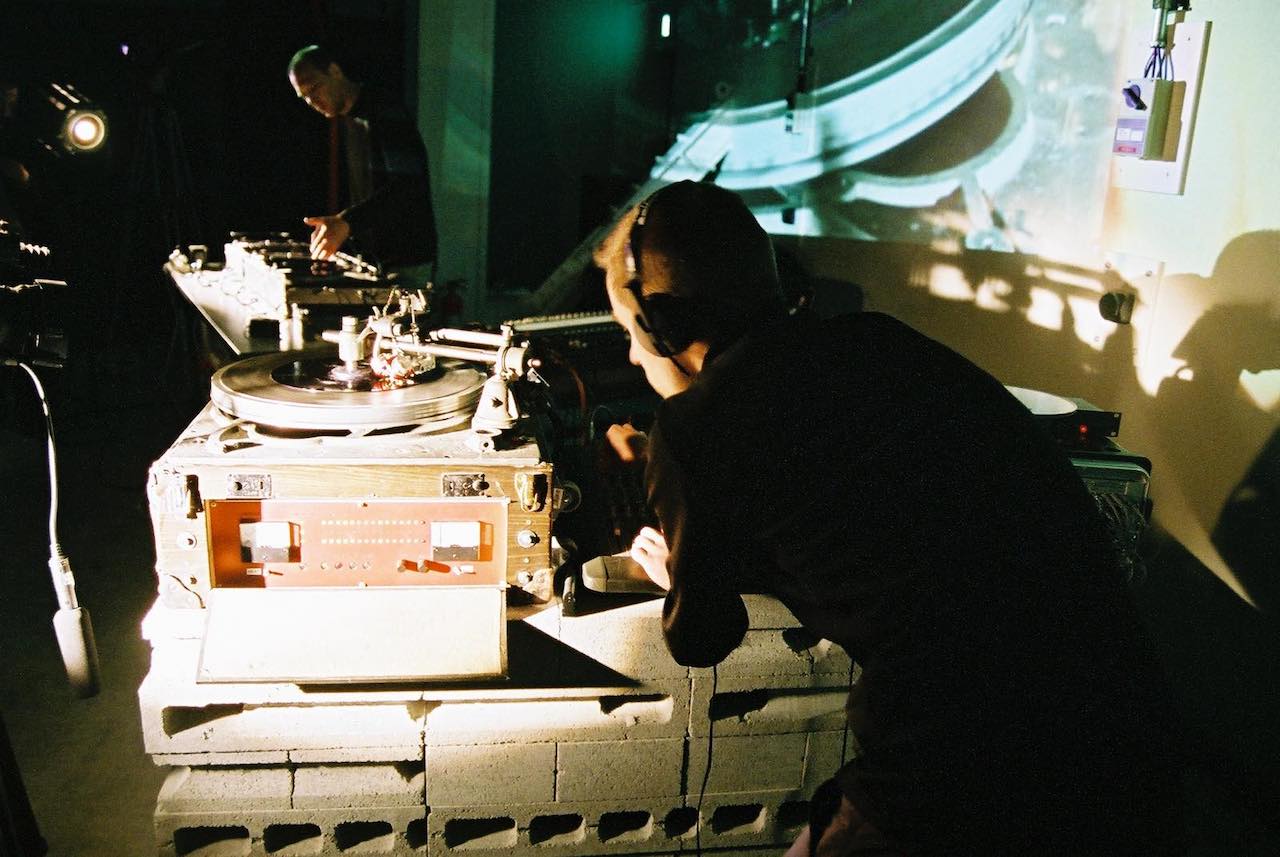
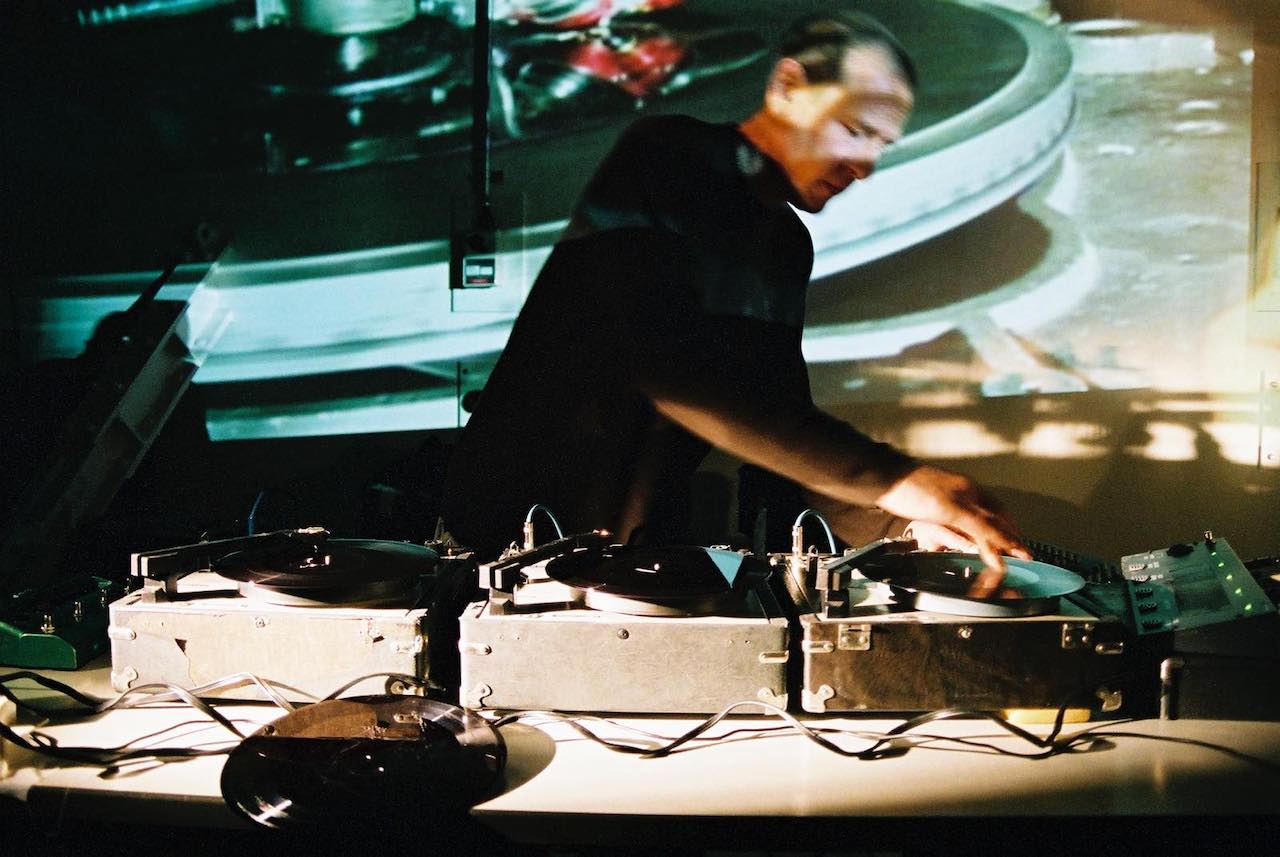
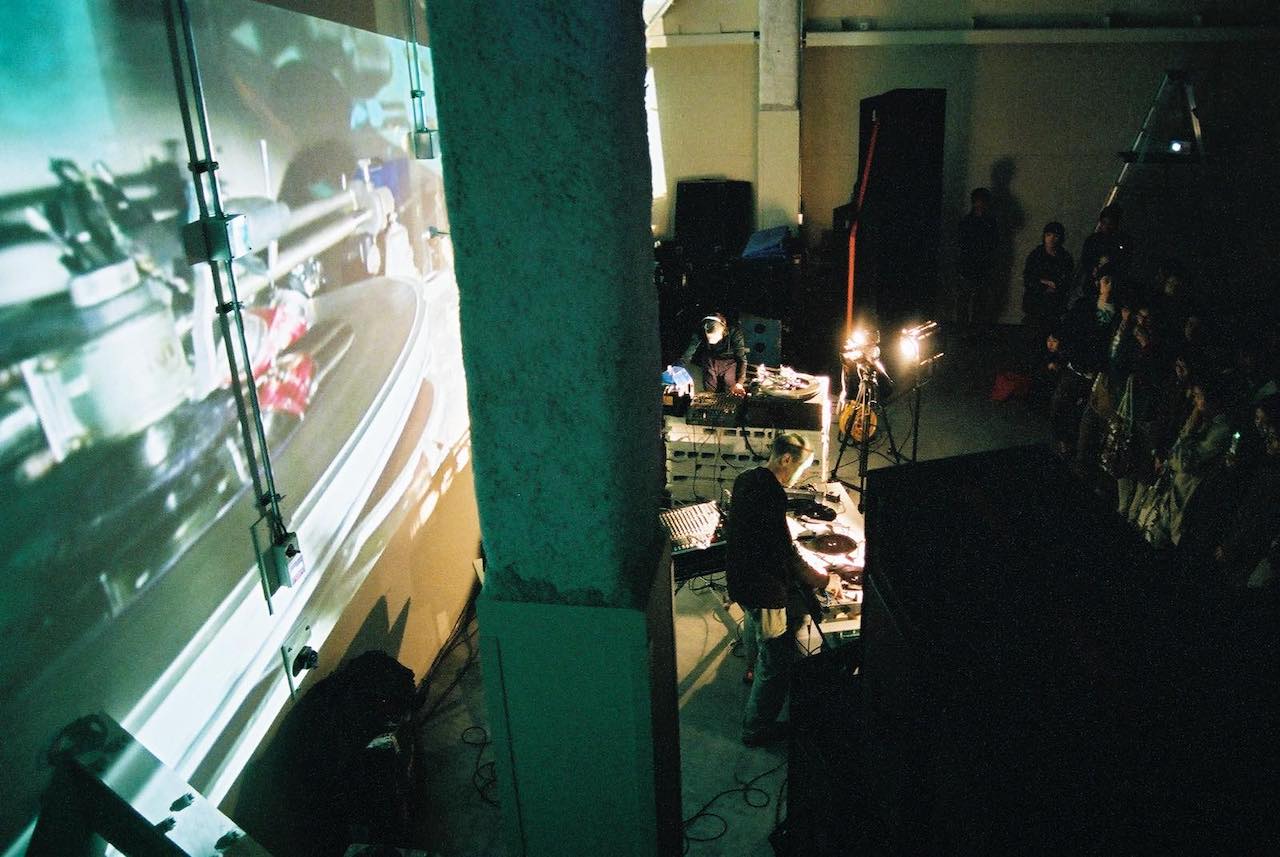
撮影:澁谷征司
Photography: Seiji Shibuya
代官山・UNITで行われたコンサートでは、刀根康尚とHeckerによる日本国内では初となるデュオに加え、マークレーとSachiko Mによる初の共演などが繰り広げられた。
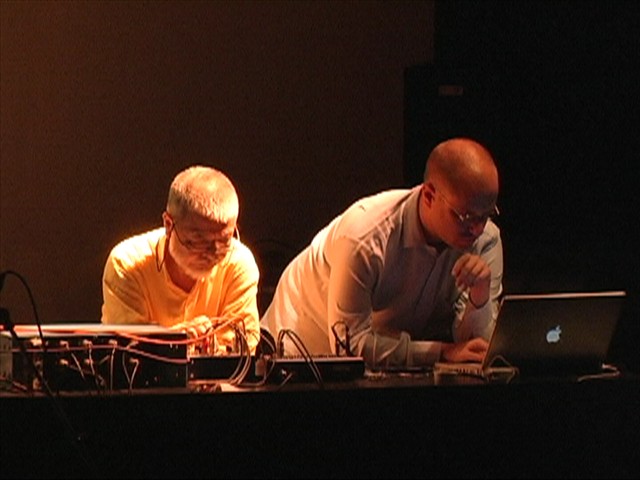



「環境」や「リサイクル」は、もっぱら社会的、政治的、経済的なコンテクストのみで語られることが多い。その最前線にアートが介入することで、このテーマをいかにとらえ直し、コミュニケートすることが可能なのか。「Variations on a Silence ──リサイクル工場の現代芸術」は、そのことを追求した。そして、この問いはまだ、私たちに開かれている。
入江拓也+井上亮(SETENV)
*『アイデア No.311』(誠文堂新光社、2005年7月)に掲載されたテキストを一部修正。
Variations on a Silence ──リサイクル工場の現代芸術
- 会期:2005年5月13日(金)-29日(日)
- 会場:リーテム東京工場(東京都大田区城南島 3-1-9)
- 出展作家:刀根康尚、クリスチャン・マークレー、近藤一弥、ポル・マロ、710.beppo、平倉圭
- 主催:株式会社リーテム
- 建築設計:坂牛卓/O.F.D.A.
- 企画・制作:SETENV
- 協力:ギャラリー小柳、白石コンテンポラリーアート
- 技術協力:株式会社メディアプロデュースジャパン
- 機材協力:ヤマハ株式会社、パイオニア株式会社
- 助成:財団法人野村国際文化財団
- ウェブサイト:https://variations.jp
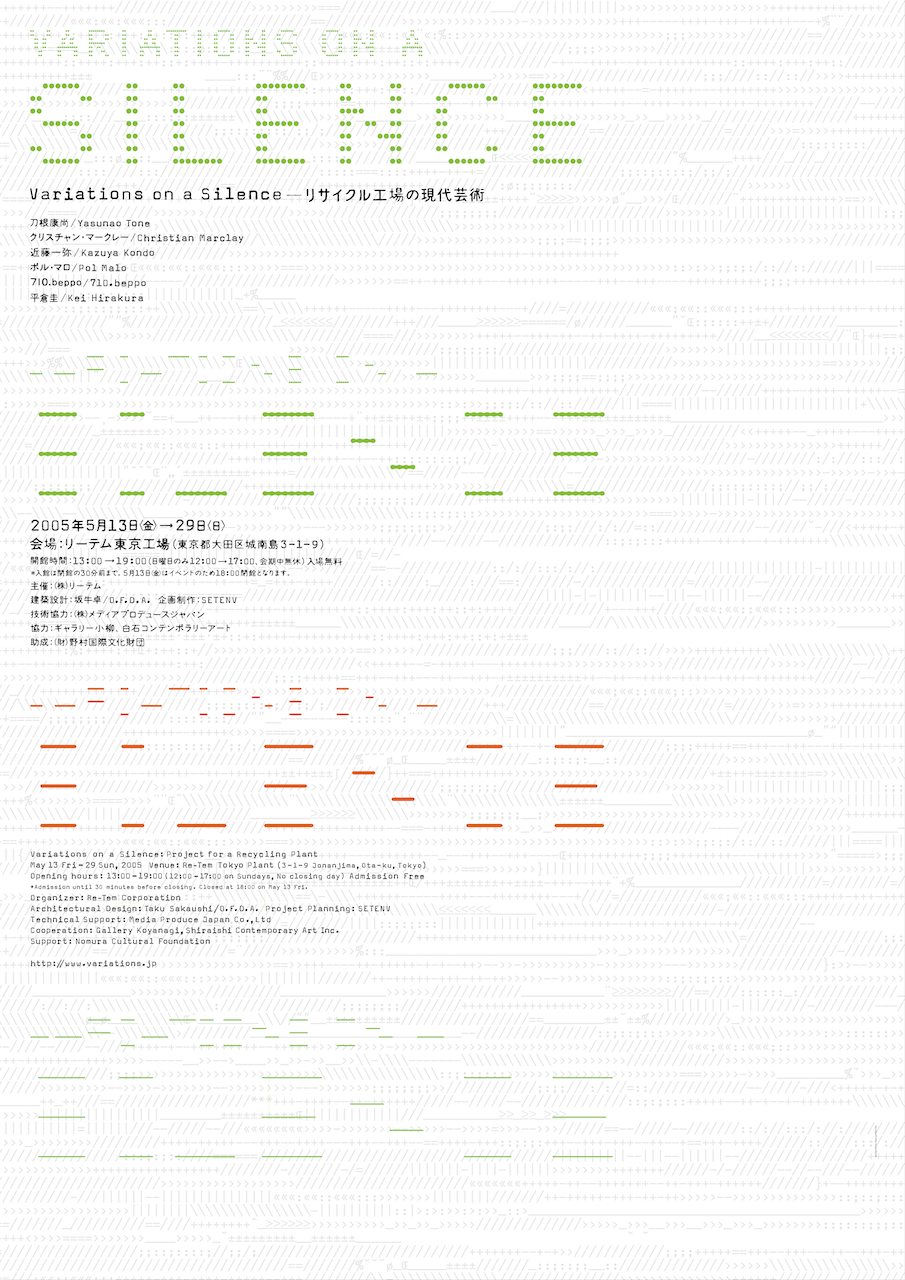
【関連企画】
Variations On a Silence : Concert
会場:代官山・UNIT(渋谷区恵比寿西 1-34-17 ザ・ハウスビル)
出演:Christian Marclay + Sachiko M、刀根康尚 + Hecker、近藤一弥、710.beppo
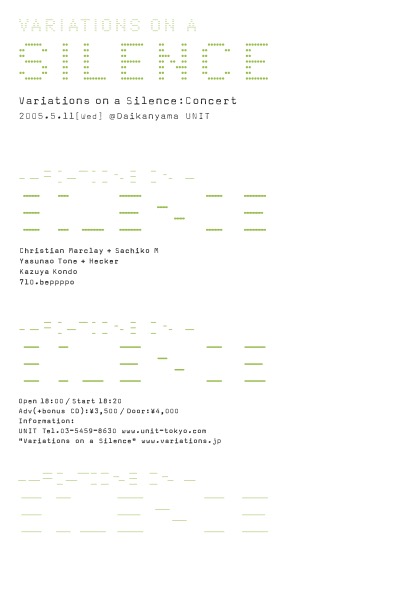
It all began when someone said to me: “Could you do something interesting in a newly constructed recycling plant?”
After hearing about the plant’s design plan and visiting its construction site, we concluded that we should host an art exhibition there. The plant is unique in that it is situated on an artificial island in Tokyo Bay, directly across from Haneda Airport. We aimed at making this landscape—along with the soundscape formed by airplanes flying back and forth overhead—an intense physical and social environment that interacts with artists’ works to resonate in various ways. Assuming such an environment, the only thing SETENV would tell the artists was that we wanted their works to be conscious of this place.
This recycling plant will mainly process metals reclaimed from electronic devices. The artists toured an existing recycling factory that was already in operation, visited the new plant’s construction site, and prepared their works while continuing such interactions. While a simple approach, such chance encounters between artists and a recycling plant formed the core of this project.
Yasunao Tone, who relocated to the United States in 1972, has had a great influence on Japanese avant-garde art through his band Group Ongaku and other projects. When music started to be released on compact discs in the 1990s, he realized some amazing results in the areas of sound art and post-techno digital music. For this exhibition, he created a sound installation that takes in ambient environmental sounds, factory work sounds, etc., and modifies them according to audience movements as detected by sensors. The resulting sounds are never the same, with visitors unwittingly taking part in a recycling process for “noise.”
Turntable pioneer Christian Marclay has garnered international attention for his installations incorporating records, musical instruments, musical scores, and sound. His submitted work featured out-of-service cellphones, desktop computers, and laptops, all showing on their screens the process by which they are disassembled and sorted. An important aspect of this presentation is that the sounds arising from the recycling process are so unlike those they make during normal operations. The genius of this work lies in that these devices seem to be relating their own unconsciousness and dreams.
Kazuya Kondo exhibited a video installation, taking as its theme Kobo Abe’s last workroom and an unfinished novel discovered on a floppy disk. This work, which has been evolving since 2002, incorporates features of the venue to create a shelter-like space, for which the video was updated. Here, reality and images reflecting that reality forever echo back and forth, like two mirrors facing each other.
Pol Malo spent a month creating an installation from large amounts of polystyrene foam scrap resulting from construction of the plant. This softly colored polystyrene forms something like a forest, from which faint aromas drift, creating a space that is simultaneously nostalgic and novel. It takes as its theme “recycling our brain,” addressing issues of recollection.
Kei Hirakura examines the dismantling process that will occur in the plant, demonstrating a state of uncertainty that he has named a “quasi-part.” Items undergoing dismantling, he finds, are vague in that they are neither “forms” with meaning, nor “materials” with their meaning completely erased. On three screens, he shows the images of the generative process for these quasi-parts, along with text attempting to describe them.
710.beppo, a unit formed by artists vokoi and Ken Furudate, use a computer to control an industrial vibrator attached to a steel plate. This work presents “music” as manipulation of vibrations in an object along a temporal axis. Visitors stand atop this “instrument,” allowing them to directly feel it. One source for this idea was vibrations from the metal crushers used in recycling plants.
Other related events were held alongside these exhibitions. “Tabula Rasa,” a conceptual performance at the plant by Marclay and Flo Kaufmann, employed turntables and record cutters to demonstrate recycling of self-generated sound. A concert held at UNIT in Tokyo’s Daikanyama district presented a Japan-first duo of Yasunao Tone and Hecker, along with the first joint performance by Marclay and Sachiko M.
“Environment” and “recycling” are generally spoken of in social, political, or economic contexts. So is it possible for art to intervene at the forefront to reinterpret and communicate these themes? This is what “Variations on a Silence: Project for a Recycling Plant” attempts to do, presenting questions that remain open to us.
Takuya Irie and Ryo Inoue (SETENV)
*Note: The above is based on an article appearing in Idea No. 311 (Seibundo Shinkosha, July 2005).
